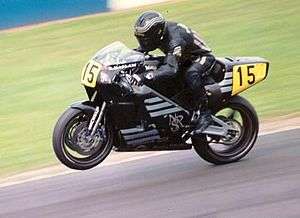MidWest AE series
| AE series | |
|---|---|
| Type | Wankel aero engine |
| National origin | United Kingdom |
| Manufacturer | Mid West Engines Ltd. |
The MidWest AE series are lightweight liquid-cooled single- and twin-rotor Wankel engines with dual ignition for light aircraft, formerly produced by Mid-West Engines Ltd. at Staverton Airport, Gloucestershire, UK.
BSA origins
This engine had its origins at the BSA Umberslade Hall research unit in Birmingham. David Garside, a BSA engineer, designed an air-cooled twin-rotor motorcycle engine that was based on the Fichtel & Sachs motor later used in the Hercules motorcycle.[1][2] Wankel engines run very hot, so Garside gave this air-cooled motor interior cooling air that was drawn first through the rotors and into a large plenum before entering the combustion chambers via the carburetors.[3] Only 100 air-cooled Norton Classics were produced. The later Norton Commander had liquid-cooling, but with the same air-cooling of the rotors as the Classic. These Norton engines had a total-loss oiling system, just like an oil-injected two-stroke engine.[3]
The MidWest engine

Very closely based on the Norton engine, the MidWest engine nevertheless took things a stage further. The lubrication system became a semi-total-loss system whereby Silkolene 2-stroke oil was directly injected into the inlet tracts and onto the main roller bearings, but the oil that fed the bearings became an oil-mist within the rotor-cooling air, and around 30%[4] of the oil was recovered and returned to the remote oil tank. Unlike the Nortons, the rotor-cooling air was forced in by a belt-driven centrifugal pump and then dumped overboard as it was considered too hot for ideal volumetric efficiency. Instead, ambient-temperature combustion air was inducted into the engine separately. Early Midwest engines had simple Tillotson carburettors, but these proved unsatisfactory, and later engines were fitted with fuel injection.[5] This gave the advantage both of excellent fuelling, and avoided any need for carb heat.
The engine gave maximum power at 7,500 rpm (the rotors turning at only 2,500rpm), but a 2.96:1 reduction gearbox (closely based on that in the Hewland AE75 engine) gave a maximum propeller rotation of an efficient 2,500 rpm.[6] Unlike the Hewland's gearbox, where the output shaft and propellor flange was below the crankshaft, the MidWest's gearbox had its output shaft higher than the eccentric shaft. This feature allowed a larger propeller and better prop clearance, while raising the height of the engine's thrust line, and reducing downward visibility over the nose very slightly.
Diamond Aircraft
Diamond bought MidWest and transferred the engine rights to Austro Engine, a company founded in 2007 and located in Wiener Neustadt. Diamond discontinued production of the MidWest twin-rotor engine, but for a period they continued with the single-rotor model, mainly for the motor glider market. Diamond then designed and produced two replacement models, both single-rotor Wankel engines: the 55 hp (41 kW) Austro Engine AE50R and the 75 hp (56 kW) Austro Engine AE75R. These new designs feature liquid cooling with forced-air rotor cooling, metered oil lubrication pumped to the main bearings (directly) and to the rotor tips (via the inlet manifold), with partial oil recovery, dual ignition, and electric starting (all of which were features of the MidWest engines). They also have electronic fuel injection.[7][8][9]
Power outputs

The Norton road bikes and racing bikes and the Midwest engines all used identical rotors. While both the Norton Classic and the Commander produced a maximum output of 85 bhp, the Midwest AE110 (with improved cooling and cold-air induction) could produce up to 110bhp. The Norton racing bike, the JPS Norton RCW588, had an even greater output of over 130bhp. The Midwest engine could in theory have had a similar output to the RCW588, but the designers opted for a lower figure in the interests of longevity and reliability.
Variants
- AE50
- Single rotor, 294 cc (18 cu in), (max) 50 hp (37 kW) at 7800 rpm, (cruise) 45 hp (34 kW) at 6900 rpm, gearbox ratio 3.23:1, 33 kg dry weight including all attached ancillaries, but excluding the exhaust[10]
- AE100
- Twin rotor, 588 cc (36 cu in), (max) 100 hp (75 kW) at 7800 rpm, (cruise) 92 hp (69 kW) at 6900 rpm, gearbox ratio 2.95:1, 53 kg dry weight including all attached ancillaries, but excluding the exhaust[10]
- AE110
- Twin rotor, 588 cc (36 cu in), (max) 110 hp (82 kW) at 7800 rpm, (cruise) 99 hp (74 kW) at 6900 rpm, gearbox ratio 2.95:1, 53 kg dry weight including all attached ancillaries, but excluding the exhaust[10]
Austro engine variants
Applications
Specifications (AE100)
General characteristics
- Type: Wankel engine
- Displacement: 588 cm³ (35.88 in³)
- Length: 720 mm (28.3 in)
- Width: 480 mm (18.9 in)
- Height: 410 mm (16.1 in)
- Dry weight: 53 kg (117 lb) (AE100/110)
Components
- Fuel system: Fuel Injection
- Fuel type: AVGAS 100/130 or Auto Gas 91 Octane Minimum
- Oil system: total-loss oil injection
- Cooling system: liquid-cooled & air-cooled
Performance
- Power output: 100 hp (75 kW) at 7,800 shaft RPM (AE100)
- Fuel consumption: 0.5 lb/bhp/hr at 70% power
- Power-to-weight ratio: 1.43 kW/kg (0.87 hp/lb)
See also
Comparable engines
Related lists
References
- ↑ The Wankel Rotary Engine: A History By John B. Hege page 137, ISBN 978-0-7864-2905-9
- ↑ Denniss, Tony (1990). "The Norton Rotary". Retrieved 14 August 2011.
- 1 2 "Cycle World" magazine February 1971
- ↑ MidWest Engines Ltd AE1100R RotaryEngine Manual
- ↑ http://www.caa.co.uk/application.aspx?catid=60&pagetype=65&appid=1&mode=detailnosummary&fullregmark=ORIX
- ↑ Midwest AE110 operator's Handbook
- 1 2 3 Austro Engine gmbh brochure Nov2 009
- ↑ Austro Engine (2007). "Rotary Engines". Retrieved 16 August 2011.
- 1 2 Austro Engine (April 2008). "Product Program – Rotary Engines AE50R" (PDF). Retrieved 16 August 2011.
- 1 2 3 "Flyer" magazine May 1994 page 38
- ↑ Johnson, Richard (September 1995). "A Flight Test Evaluation of the ASH-26E Self Launching 18-Meter Sailplane" (PDF). Retrieved 27 August 2011.